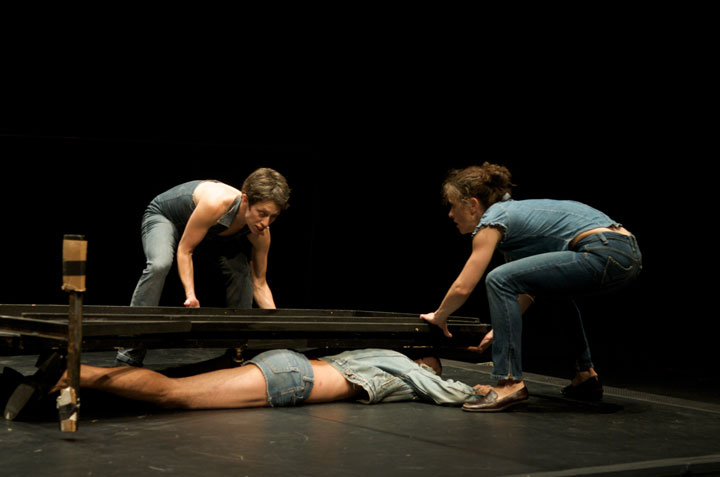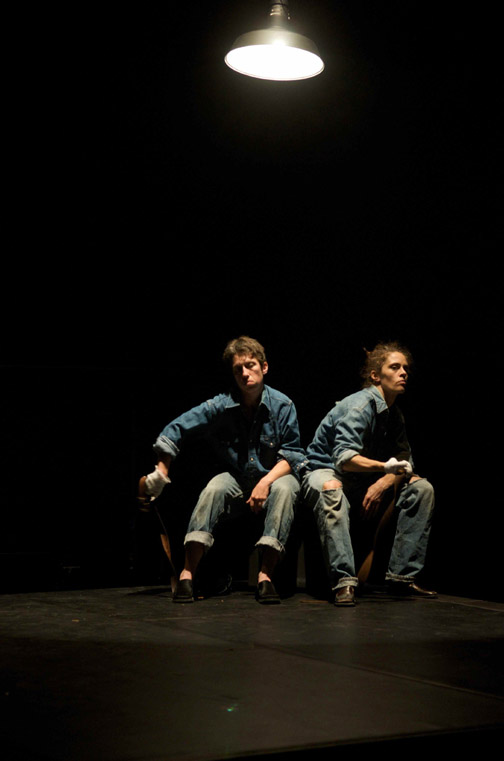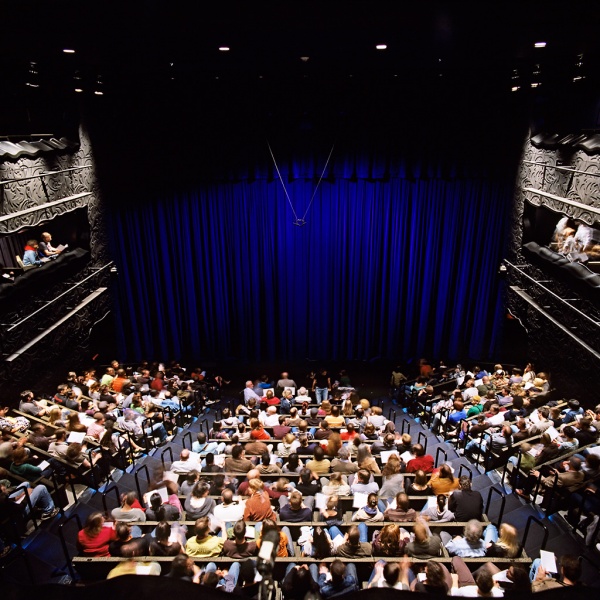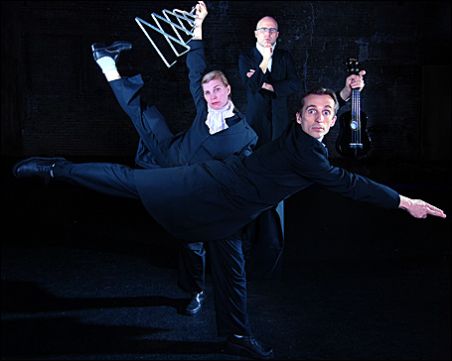A First Look at “smithsoniansmith (as is)”
Lightsey Darst previews the densely layered "smithsoniansmith," a new dance work by the HIJACK duo and Scott Heron. Darst will review the show again this spring, when the artists plan to perform it as a larger-scale production.





THIS SATURDAY (10:30) OR SUNDAY (7:30) at Bedlam, go see smithsoniansmith (as is). First, you should see it because this is the first evening-length work from Hijack (the Minneapolis-based duo of Kristin Van Loon and Arwen Wilder) and Scott Heron (their New Orleans-based frequent collaborator). Second, while Hijack can be hard to track — a one-off performance here, a fifteen-minute snippet there — this performance is a "take 1" for a more finished version scheduled for this spring; so, you've got a rare chance here to follow Hijack's work closely.
But here are the real reasons to see this show: I don't know whether Hijack and Heron actually work harder than anyone else, but they certainly work in more — and more deliberate — layers than anyone else. For them to explain where any one moment comes from takes ten minutes, and that ten minutes takes the listener on a mental archaeological dig. Why is there so much denim in smithsoniansmith? Well, jeans were called for in a Jean Genet play that the artists stripped down to a heap of stage directions, in order to find new sources for movement; plus Heron went thrifting in Minneapolis and came back with a denim outfit (a Sunday school teacher's numbingly modest dress, which fits him perfectly); plus they'd been digging through some Sam Shepard in their search for stage directions, and Shepard's Western fetish fit neatly with their evolving denim fascination. And once they had the denim, well, denim is so great, it has such rich associations (work, America, class, rebellion, etc) — oh, and they've been playing around with the idea of one performer wearing every piece of their big pile of jeanswear, draping it over and around the person until you've got a sort of sculpture-as-costume going on… Dizzy yet?
This layering makes them compelling performers, even when you haven't got a clue what they're doing, because each moment is laden with such intention that there's no risk of them simply performing, simply executing. It also makes the dance itself kaleidoscopic — I would say prismatic if that word didn't carry an association of polish far removed from Hijack's lo-fi, frayed-edge, found-object aesthetic. Simply put, there are many convincing ways to see each moment. Taking the title as my starting point (Smithsonian-smiths, that is, people who build Smithsonians), I interpolated an entire theme of collecting, diorama-building, and observing the behavior of "primitive" people — a theme they later told me they'd never intended. (They have their own intentions, which they can articulate, but often these remain "on the back side of the embroidery" — they're not what you see.) But it didn't detract from my viewing to be so "mistaken". In fact, this open-endedness is one of the prime pleasures of watching Hijack: you think they're doing one thing, when they're really doing something else (even down to the level of a simple weight shift). But, regardless of their initial intention, because you thought they were doing it, in a refracted, objects-in-the-mirror-are-stranger-than-they-appear sort of way, they were doing it.
______________________________________________________
It's hard to write a piece about Hijack that goes beyond "another quirky bag of tricks from those wacky Hijack girls!" — the details in their shows are so catchy and so fun to write about. But trust me, there's much more to see and feel than quirk.
______________________________________________________
All this gives me a forest-for-the-trees problem when I'm writing about Hijack. The details are so catchy, and so much fun to write about (take the enormous assemblage, sprouting junk in all directions, that Van Loon slowly pushes forward like an extroverted bag lady, or the delicious little moment when all three performers whisper sexy nothings to pairs of jeans draped over mic stands), while the big picture's so difficult to capture; it's hard to write a piece that goes beyond "another quirky bag of tricks from those wacky Hijack girls!" And trust me, there's much more to see and feel than quirk.
So here's an effort: you've already heard about the surface of the work, how it plays with your viewing, how it's funny and surprising and familiarly strange/strangely familiar. On the large scale, In smithsoniansmith I saw a lot of collecting and building, and interactions of such precious care they reminded me of religious ceremonies or séances, rituals that seek, through the perfection of performance, to invoke a higher power. I also saw the reverse of these: throwing away, destroying, sudden arbitrary disconnection, despair. With smithsoniansmith, Hijack and Heron are not making a comment — they're never that transparent — but they're calling attention to and raising some questions about what I'd call treasuring: that activity of marking out a particular object or activity as different, special, worth keeping.
AT LEAST, THAT'S WHAT I HAVE TO SAY NOW, in my very first encounter with this work. So often a critic gets just the one encounter; "view" would be a more accurate label than "review". But to re-view, re-read, re-visit is often revelatory. Do you know Yeats, New York City, or your favorite film from a single encounter? I often see a dance more than once, but generally only after I've written about it. Critical writing on film, literature, and other forms often presupposes multiple contacts, while dance is stuck in a one-take paradigm.
But with smithsoniansmith, we're going to try something different. Consider this the first view; in June 2010, look for a re-view — a second look, with new thoughts on the work, new thoughts on the old thoughts, and plenty of thinking about re-viewing.
*****
You can get in some second views yourself this fall if you check out this weekend's showcase concerts. The Walker's fall preview of the art center's performing arts season, genially hosted by Philip Bither, is Thursday, September 10, and free.
For a more extensive fall preview, with live performance, see 8 @ 8 this Thursday and Friday. 8 @ 8 is the first performance manifesting a new organization in town, the CIA. No, not that CIA — this is Choreographers In Accord, started this spring by Ballet of the Dolls Artistic Director Myron Johnson. "I wanted to have a group of artistic directors that could meet regularly, share ideas, compare schedules, share resources, drink wine and just be comrades and talk," Johnson says. Lucky for us, they also decided to do a concert together. And since CIA features some Twin Cities all-stars rarely seen on the same stage — Jawaahir and Flying Foot Forum, Ethnic Dance Theatre and Zenon, TU Dance and Zorongo Flamenco, Shapiro & Smith and Katha Dance Theatre — this concert should be a great smorgasbord. (If you were counting, that's eight right there. The Dolls are extra, sneaking in with a Stephanie Fellner solo — so perhaps this should be called "8 1/2 @ 8"!)
______________________________________________________
Noted performance details:
smithsoniansmith (as is), presented by Hijack and Scott Heron, will be on stage at the Bedlam Theatre in Minneapolis Saturday, September 12 (10:30 pm) and Sunday, September 13 (7:30 pm).
Walker Art Center's "Performing Arts Season Preview" is Thursday, September 10 (7 pm), in the McGuire Theater. Admission is free.
Choreographers In Accord presents 8 @ 8, a sampling of work by eight Twin Cities dance companies, on Thursday, September 10 (8 pm) and Friday, September 11 (8 pm). General admission tickets are $15.
______________________________________________________
About the writer: Lightsey Darst writes on dance for Mpls/St Paul magazine. She is also a poet who served as the founding coordinator of mnartists.org's What Light: This Week's Poem publication project, and the founder and host of a monthly writers' salon, The Works, at the Bryant Lake Bowl.